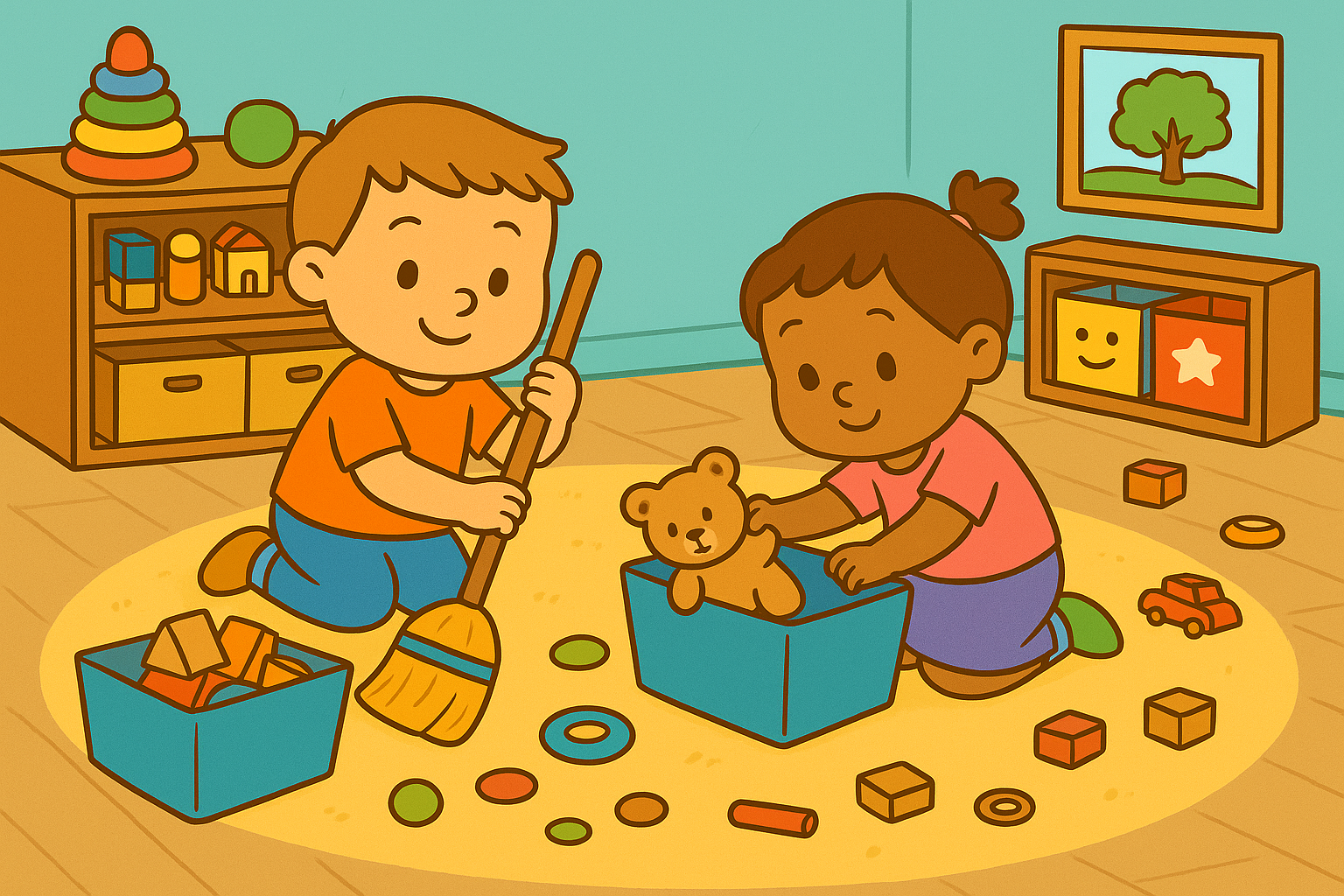Teaching Kids to Clean Up Without Resistance
Teaching Kids to Clean Up Without Resistance
Cleanup time doesn’t need to be a fight. Children naturally resist cleaning when it feels like punishment, interruption, or loss of control. But when cleanup becomes predictable, playful, and connected to routine, children become more willing—and sometimes even eager—to participate.
Teaching kids to clean up is not just about organizing toys; it’s about building responsibility, independence, and teamwork. When cleanup time is structured with care, children learn that they are capable contributors to the home—and that their environment is something they can help care for, not just use.
Why Cleanup Time Feels Hard for Kids
Children are usually deep in their imagination during play. Asking them to stop abruptly can feel like losing a world they created. Understanding this helps adults respond with empathy instead of frustration.
Common reasons for resistance:
Sudden interruption of meaningful play
Lack of visual structure
Unclear expectations
Overwhelmed by mess size
No sense of ownership
Tension from rushed instructions
Cleanup is more successful when children feel guided—not forced.
Preparation Makes a Big Difference
Before cleanup time begins, emotional readiness matters. Just as seen in How to End Screen Time Without Fights, preparation is key to smoother transitions.
Helpful pre-cleanup strategies:
Announce time before it starts
Give countdown warnings (“5 more minutes”)
Offer choices: “Do you want to start with blocks or books?”
Use a familiar cleanup phrase or musical cue
Establish routine: cleanup always happens before dinner / walk / etc.
Children relax when they know what’s coming.
Make Cleanup Predictable With Routines
Children cooperate more when cleanup follows a consistent flow. Predictability builds confidence and decreases overwhelm—similar to strategies in Creating Predictable Transitions Between Activities.
You might try:
Picture-based cleanup charts
Toy zones or color-coded bins
Short “room reset” after each activity
Cleanup before meals as a built-in rhythm
Routine cue lights or music
Routine becomes the signal—not the adult’s voice.
Use Music and Rhythm to Stimulate Cooperation
Music can transform cleanup from a chore to a game. As explored in Using Music as a Routine Cue for Kids, rhythm invites children into action naturally.
Musical cleanup strategies:
One-song cleanup challenge
Drum or shaker to signal start
“Find and return” rhythm game
Move like different animals while cleaning
Freeze dance cleanup
Movement and music make cleanup feel like play—not pressure.
Break Tasks Into Small Steps
Many children resist cleaning because they don’t know where to start. Breaking the task down makes it more manageable.
Helpful prompts:
“Let’s find five blue toys.”
“Can you fill this basket?”
“Let’s put away everything with wheels first.”
“Start with one corner.”
“Which toy wants to go home?”
Tiny steps create big momentum.
Use Visual Sorting Systems
Visual organization helps children understand where things belong and why cleaning matters. Over time, it builds independence.
Visual strategies:
Labeled bins with pictures
Color-coded shelves
Toy mats that fold into storage
Sticker-based sorting game
Storage zones (“quiet toys,” “building toys,” etc.)
This approach is helpful for visual learners—similar to ideas in How to Use Routine Charts for Visual Learners.
Share Responsibility as a Team
Children participate more when they feel like helpers, not workers. Cleanup can become a moment of connection rather than conflict.
Team-based strategies:
“I’ll do this part, you do that part”
Family timer — beat the clock together
Partner cleanup with siblings
“We all clean what we used” motto
Rotating cleanup jobs for variety
Togetherness builds willingness.
Use Language That Encourages Ownership
Words shape how children think about cleanup. Supportive phrasing reduces resistance and builds capability.
Try saying:
“Let’s help your room get ready for tomorrow.”
“Where does this toy live?”
“Can you show me where this belongs?”
“We take care of our things.”
“This room looks proud of you.”
Language influences motivation more than instructions.
Celebrate Effort, Not Perfection
Cleanup doesn’t need to be flawless to be meaningful. Effort is what builds responsibility over time.
Celebrate with:
High-fives or fist bumps
“Before and after” photo comparisons
Proud moment journal
Stickers for effort—not speed or perfection
Quick gratitude check: “Doesn’t it feel good to see the floor again?”
Praise action—not accuracy.
Adjusting Cleanup for Different Ages
Younger children need more modeling and guidance. Older children can take more ownership—but still benefit from structure.
Age-based approaches:
Toddlers: one-step cleanup (“put it in this basket”)
Preschoolers: matching bin games and sorting
Early elementary: daily cleanup zones + checklists
Older kids: choose music, lead siblings, set timer
Cleanup evolves—but the values remain the same.
When Cleanup Becomes an Expression of Care
One day, children begin to clean up not because they’re told to—but because they’ve learned that caring for their space feels good. Cleanup becomes part of belonging—and belonging becomes part of identity.
And that’s far more than tidy rooms. It’s the start of capability, pride, and maturity—built one routine at a time.
This content is for educational purposes and is not a substitute for professional medical or psychological advice.
Popular Parenting Articles


